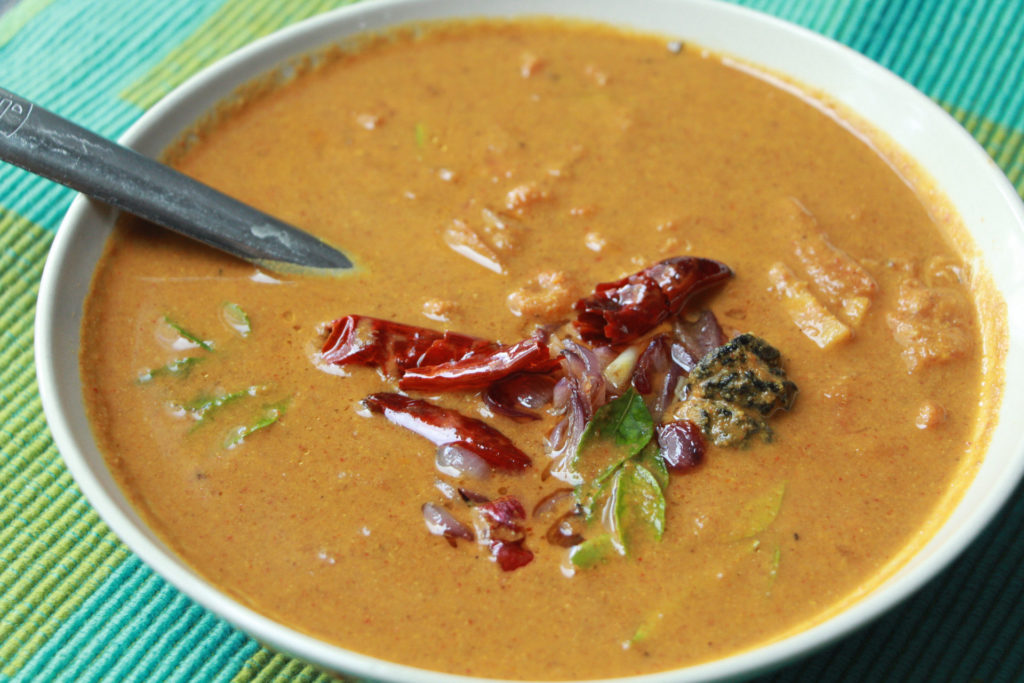
Hailing from Kerala (a southern state in India), seafood has always been a part of my life. My achan’s (dad’s) hometown was near the coast and fish had been an integral part of the cuisine there. In addition to all the bounty from the sea, he had 2 large ponds filled with freshwater fish in his backyard. Fish was a part of the everyday menu at his home. My amma (mom), not hailing from a coastal town, was amazed at the abundance of fish at his place. As she was coming from a mostly vegetarian household, it was a big transition for her. Fish curry and fish fry were a regular part of the menu there, along with a few vegetarian curries. She was shocked to learn that fish was even used as a fertilizer there. But she ended up leaning how to make amazing seafood recipes though she still hasn’t acquired a taste for seafood.
We grew up enjoying the amazing seafood cooked by my mom, though we did not have it everyday. I am making one of her recipes today, shrimp theeyal. Theeyal is made with roasted and ground coconut. A special ingredient called kudam puli imparts a unique tartness to the curry which is associated with Kerala seafood recipes. It is a dried fruit and is also called Malabar tamarind or, Garcinia cambogia. Use slices of raw mango as a substitute if you do not have this ingredient.

As for the shrimp itself, I used frozen shrimp, more for ease of use. Frozen or fresh, the choice is yours, it doesn’t matter. The shrimp theeyal will taste amazing. I used smaller sized shrimp for making this curry. If using large shrimp, around 12- would be a good number here.

Chemmeen theeyal / Shrimp curry
Ingredients
- 2 cups small shrimp-frozen/fresh Large ones are also fine
- ½ tsp Turmeric powder
- 1½ tsp Chili powder
- 2" piece Ginger, cut into long slices
- 2-3 cloves Garlic, sliced thin
- ½ cup Coconut, fresh or desiccated (See notes 1)
- 4 Dry red chillies
- 6 Pearl onions, sliced thin
- 2 tbsp Coriander powder
- 1-2 sprigs Curry leaves
- 1 large Tomato, cut into small pieces
- 2 pieces Kudam puli or Garcinia gummi-gutta, rinsed in water
- A pinch Fenugreek powder
- To taste Salt
- 1-2 tbsp Coconut oil
Instructions
Shrimp Prep
- Defrost the shrimp, if using frozen. Soak the frozen shrimp in cold water for 10-20 minutes. Change the water a couple of times and make sure you have submerged all the shrimp underneath it. Or add some salt to the water and soak the shrimp for 10 minutes.Drain the water and keep aside. If using fresh shrimp, clean, devein and proceed with step 2.
- Marinate the shrimp in turmeric powder, chili powder and salt for a few minutes while you make the roasted coconut masala.
Coconut masala
- Take 1 tsp of coconut oil in a pan, add half of the sliced ginger, all of the garlic, 3 dry red chillies, half of the sliced pearl onion, a few curry leaves and the grated coconut and roast on medium flame.
- When the coconut starts turning dark. lower the flame, add the coriander powder and mix well. Switch off. Take care not to burn the coconut. Remove to a plate and let it cool down.
- In a blender/mixie jar, first powder the coconut mixture and when it is all crushed well, add enough water and grind to a fine paste. Keep aside.
Making of the curry
- In a medium sized pot, add the marinating shrimp, Garcinia or kudampuli, remaining sliced ginger along with a few curry leaves, a half cup of water and cover and cook till the shrimp is cooked half way through (around 5 minutes for the frozen shrimp).
- Open the lid and add the ground masala, along with around 2 cups of water and salt. Cover and cook for 3-4 minutes.
- Open and add the sliced tomatoes. You can remove the garcinia or kudampuli at this stage if you feel the curry is becoming too tart.
- Cook for another 2-3 minutes and switch off.
- Heat oil in a small pan, add coconut oil.
- Add the remaining pearl onions and fry till the pearl onion slices are translucent.
- Add a pinch of the fenugreek powder, mix well and pour over the curry.
- Let it rest for 10 minutes. Serve with rice and enjoy.
Notes
- Use fresh or dry dessicated coconut. The fresh coconut takes longer to turn brown, so you can add it with rest of the garlic and ginger. But if using dry coconut powder, which can brown very very quickly, let the ginger, garlic, pearl onion etc roast for a few minutes and then add the coconut.
- Remember that tartness increases if you leave the garcinia in the curry. So when you feel the curry is tart enough for you, please discard the kudampuli.
- Shrimp curry can turn spicy very quickly, so please be careful with chili powder.
- Take care not to overcook the shrimp.
- Use 3-4 slices of raw mango in place of the garcinia or kudampuli, if you do not have it.

